Ancient Reptilian-Like Humanoids Hold Secrets Of Mankind’s Origin
A. Sutherland - AncientPages.com - The reptilian appearance of the gods in the Old Testament was a well-kept secret but the Sumerians were more open and in their epics, which can be traced as far back as 3000 BC, called their gods U-SHUM-GAL, or “great fiery flying serpent.”
They have been called the "Nagas" ("snakes") in India, the Quetzalcoatls ("Plumed Serpents") in Mexico, the Djedhi ("snakes") in Egypt, the Adders ("snakes") in Britain and the Lung ("dragons") in China.
The Toltec Mayan god Gugumatz was described as a "serpent of wisdom" - a feathered snake god, one of all three groups of gods who created Earth and humankind and gave them knowledge.
Ancient references to “serpent gods,” “flying serpents,” and “dragons” are quite common. Collectively they have been called - the "Serpents of Wisdom".
These enigmatic figurines, dated to the so-called Ubaid period in Ur (6000 to 4000 BC) were unearthed by Sir Charles Leonard Woolley (17 April 1880 - 20 February 1960), a British archaeologist best known for his excavations in the 1920s and 1930s in Mesopotamia.
The figurines depict snake- or reptilian-headed humanoids that were found in several Ubaid cemeteries in the vicinity of Ur, southern Iraq.
This is a preview of our premium article available only to members of Ancient Pages.
Become a member to read more - Click here
If you are already a member and have logged in to your account, you can access the article here
More From Ancient Pages
-
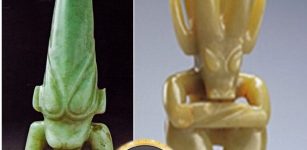 Ancient Hongshan Culture: Creators Of A Pyramid And Remarkable Artifacts That Are Still Shrouded In Mystery
Ancient Mysteries | Jun 20, 2015
Ancient Hongshan Culture: Creators Of A Pyramid And Remarkable Artifacts That Are Still Shrouded In Mystery
Ancient Mysteries | Jun 20, 2015 -
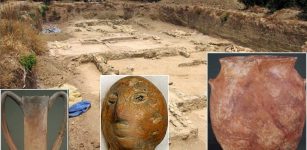 Legendary Helike – Uncovering Lost City of Poseidon
Civilizations | Dec 19, 2018
Legendary Helike – Uncovering Lost City of Poseidon
Civilizations | Dec 19, 2018 -
 Enigmatic Green Lady In British Folklore
Featured Stories | Jan 9, 2017
Enigmatic Green Lady In British Folklore
Featured Stories | Jan 9, 2017 -
 Ancient Secrets Of Polish Ciemna Cave Inhabited By Humans 120,000 Years Ago
Featured Stories | Nov 22, 2016
Ancient Secrets Of Polish Ciemna Cave Inhabited By Humans 120,000 Years Ago
Featured Stories | Nov 22, 2016 -
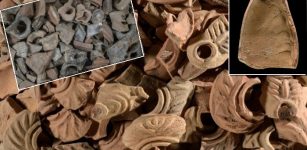 1,500-Year-Old Fingerprints Will Say Much About Potters And Communities That Once Lived In Motza
Archaeology | Nov 10, 2022
1,500-Year-Old Fingerprints Will Say Much About Potters And Communities That Once Lived In Motza
Archaeology | Nov 10, 2022 -
 ‘Face Of First European’ – Oldest Fossil Of European Human Ancestor Found At Spain’s Atapuerca Archaeological Site
Archaeology | Jul 9, 2022
‘Face Of First European’ – Oldest Fossil Of European Human Ancestor Found At Spain’s Atapuerca Archaeological Site
Archaeology | Jul 9, 2022 -
 More Than 27,000 Artifacts Illegally Collected By ‘Expert In Archaeology’ – Seized In France
Artifacts | Dec 18, 2020
More Than 27,000 Artifacts Illegally Collected By ‘Expert In Archaeology’ – Seized In France
Artifacts | Dec 18, 2020 -
 Unexplained Ancient Case Of Missing Time And Mysterious Disappearance Into An Underground World
Featured Stories | Feb 11, 2025
Unexplained Ancient Case Of Missing Time And Mysterious Disappearance Into An Underground World
Featured Stories | Feb 11, 2025 -
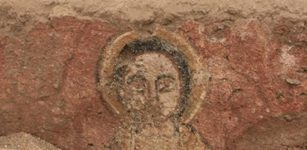 1,000-Year-Old Paintings Unearthed In Sudan – Documented By The Polish Researcher
Archaeology | Sep 25, 2022
1,000-Year-Old Paintings Unearthed In Sudan – Documented By The Polish Researcher
Archaeology | Sep 25, 2022 -
 On This Day In History: Greek Archaeologist Manolis Andronikos Who Discovered Tomb of Philip II of Macedon, Was Born – On Oct 23, 1919
News | Oct 23, 2016
On This Day In History: Greek Archaeologist Manolis Andronikos Who Discovered Tomb of Philip II of Macedon, Was Born – On Oct 23, 1919
News | Oct 23, 2016 -
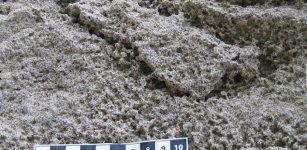 First Neanderthal Footprints Discovered In Gibraltar Dunes
Archaeology | Feb 14, 2019
First Neanderthal Footprints Discovered In Gibraltar Dunes
Archaeology | Feb 14, 2019 -
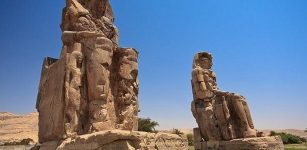 Colossi Of Memnon: Gigantic Stone Statues Guarding The Temple Of Pharaoh Amenhotep III
Civilizations | Jul 13, 2016
Colossi Of Memnon: Gigantic Stone Statues Guarding The Temple Of Pharaoh Amenhotep III
Civilizations | Jul 13, 2016 -
 Evidence Of Carthaginian Presence In Northern Europe?
Featured Stories | Jun 18, 2022
Evidence Of Carthaginian Presence In Northern Europe?
Featured Stories | Jun 18, 2022 -
 Entrance To An Unexplored Ice Age Cave Discovered Near Engen!
Archaeology | Aug 4, 2023
Entrance To An Unexplored Ice Age Cave Discovered Near Engen!
Archaeology | Aug 4, 2023 -
 Ancient Oral History Of Lake Babine First Nation Confirmed By Archaeologists
Archaeology | Jan 29, 2019
Ancient Oral History Of Lake Babine First Nation Confirmed By Archaeologists
Archaeology | Jan 29, 2019 -
 Strange And Scary Encounter With Ancient Giants In North America
Ancient Mysteries | Sep 23, 2021
Strange And Scary Encounter With Ancient Giants In North America
Ancient Mysteries | Sep 23, 2021 -
 Controversial Hollow Earth Theory – Questions And Answers – Part 3
Ancient Mysteries | Jun 28, 2019
Controversial Hollow Earth Theory – Questions And Answers – Part 3
Ancient Mysteries | Jun 28, 2019 -
 Lost Since 1362: Researchers Discover The Church Of Rungholt – A Sunken Medieval Trading Place
Archaeology | May 25, 2023
Lost Since 1362: Researchers Discover The Church Of Rungholt – A Sunken Medieval Trading Place
Archaeology | May 25, 2023 -
 Norse Kingdom Of Dublin Was Founded By The Vikings In 839 A.D.
Ancient History Facts | Mar 15, 2016
Norse Kingdom Of Dublin Was Founded By The Vikings In 839 A.D.
Ancient History Facts | Mar 15, 2016 -
 Rare Discovery: 530 Knuckle Bones ‘Astragali’ For Gaming And Divination Unearthed In Ancient City Of Maresha
Archaeology | Aug 16, 2022
Rare Discovery: 530 Knuckle Bones ‘Astragali’ For Gaming And Divination Unearthed In Ancient City Of Maresha
Archaeology | Aug 16, 2022



